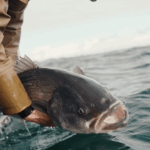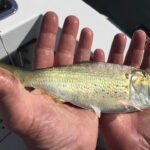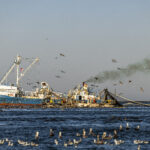
Release Mortality Revisited: New Research from Massachusetts DMF
Feature Photo Credit: Robbie Tartaglia What’s going on? For decades, striped bass management relied on a
We know that the Public Information Document (PID) for Amendment 7 to the Interstate Fishery Management Plan for Striped Bass is a little overwhelming. It was tough for us as well. But with the striped bass population at a 25-year low, now is the time for anglers get involved and make their priorities heard. Comments on the PID will be used to help decide which issues become part of the amendment process. Some aspects of striped bass management, like conservation equivalency, certainly need to change. Others, like reference points and rebuilding timelines, should stay the same to help us get the stock back on track and to a healthy level. In this blog, we outline the major issues and our talking points, as well as instructions for providing public comment.
Send your comments to comments@asmfc.org and cc your state Striped Bass Board members. The full list of Board members, along with their email addresses, can be found here. Just like with the last addendum, we are running a raffle through The Saltwater Edge. Click the link for prize details. It doesn’t matter what position you take. We just want to know that you commented. To enter, just cc stripercomments@gmail.com when you submit your comments to ASMFC. We will pick random winners after the deadline on April 9.
For those who would prefer to give verbal comments at their state’s public hearing, included below is the full list of hearings. Note that North Carolina will not have its own hearing; folks from that state should instead attend the hearing of another state. Register for your state’s hearing by clicking here.
Once again, here is the link to the full PID at ASMFC’s website.
For those who want to take a deeper dive, here are our full comments to ASMFC (click here to download the PDF).
If you don’t have time to fully review all of the documentation, we have prepared a two page document as a quick reference for comments.
For those who’d rather listen than read, we lay out what’s on the table in the PID in the inaugural episode of our new podcast, the Guide Post. Listen and subscribe on Spotify or iTunes. This podcast is presented by Costa Sunglasses.

If you don’t have time for any of this, here are the top talking points issue by issue. While all of these issues are important, we have emphasized in bold the three issues that we believe it is most important for folks to weigh in on at this stage.
Issue 1—Goals and Objectives: We believe that the current goal and objectives for the fishery are sufficient recommend that this issue be removed from further consideration for inclusion in Amendment 7.
Issue 2—Biological Reference Points: We continue to believe that 1995 is an appropriate reference year, and recommend that the BRPs remain unchanged and that this issue be removed from further consideration in Amendment 7.
Issue 3—Management Triggers: The four management triggers related to spawning stock biomass and fishing mortality continue to be appropriate. We do believe that it may be prudent to revisit Trigger 5, which attempts to address recruitment failure but whose specifications (if any juvenile abundance index is lower than 75% of all other values in the dataset for three consecutive years) may not be an appropriate indicator of such a failure given the stochastic nature of recruitment.
Issue 4—Stock Rebuilding and Target Schedule: We strongly believe that the 10-year rebuilding timeline currently specified in Amendment 6 should be maintained, and that a rebuilding plan should be initiated for Atlantic striped bass as soon as possible.
Issue 5—Regional Management: Given the combination of current striped bass status and the fact that the science is not available to inform stock-specific or regional management, we recommend removing this issue from further consideration in Amendment 7.
Issue 6 —Conservation Equivalency: We believe that CE should only be considered if striped bass are neither overfished nor experiencing overfishing, given the greater inherent uncertainty that CE injects into the management process. States that do choose to implement CE must be held accountable should their regulations fail to meet stated conservation objectives.
Issue 7—Recreational Release Mortality: We believe that addressing this issue in Amendment 7 is rather premature given that the Massachusetts Division of Marine Fisheries is in the midst of a multi-year study to assess the impacts of various fishing methods and gear types on striped bass post-release mortality. That being said, at this point in time we recommend that efforts to reduce release mortality focus on outreach and education to anglers in order to promote best practices for safe release.
Issue 8—Recreational Accountability: The issue of recreational accountability is a complex challenge that applies not only to striped bass but to all recreational species under the jurisdiction of the ASMFC. We view this as a much larger endeavor that is not sensible to try to address within the confines of this amendment process. As a result, we recommend the removal of the issue of recreational accountability from further consideration in Amendment 7, except as it pertains to accountability for states that implement CE (see Issue 6).
Issue 9—Commercial Allocation: We recommend that the Striped Bass Board work with the Technical Committee to update commercial allocations in a manner that better reflects the characteristics of today’s commercial striped bass fishery.
Issue 10—Other Issues: We recommend inclusion in Amendment 7 guidance for expanding human dimensions research in the striped bass fishery and provide a pathway by which such research could be applied to future management discussions. We also recommend that the Striped Bass Board support research to better understand the relative contributions of individual striped bass spawning stocks to the overall coastal population targeted by anglers. as such efforts could ultimately inform stock-specific management and ensure the long-term vitality of the striped bass population and fishery.
Now is the time to make your voice heard and to help ensure a future that includes a healthy striped bass population and fishery. Please, take a few minutes to share your views with members of the Striped Bass Board.

Feature Photo Credit: Robbie Tartaglia What’s going on? For decades, striped bass management relied on a

Recent developments in the 2025 Atlantic Menhaden Stock Assessment Update, released by the Atlantic States

What’s going on? The “most important fish in the sea” just exposed one of the

Mario CampoFisheries Ecologist, Southeastern Louisiana UniversityScience and Policy Associate, American Saltwater Guides Association This discussion
We rely on our members and donations to keep fighting for a sustainable tomorrow in marine conservation.
GIVE THE GIFT OF FISHERIES CONSERVATION THIS HOLIDAY SEASON. SHOP ASGA GOODS THAT FUND FISHERIES RESEARCH & ADVOCACY CAMPAIGNS
JOIN ASGA IN CALLING FOR CRITICAL MANAGEMENT ACTION AFTER YEARS OF SPAWN FAILURES & POOR MANAGEMENT.
By using this website, you agree to our use of cookies. We use cookies to provide you with a great experience and to help our website run effectively. To learn more, please review our privacy policy.
10 Responses
This is an appropriate time to get things going for future generations.
Both Guide Post podcasts were really well done and excellent for coming up to speed on these important topics. Well worth the time for anyone looking to hear a straightforward explanation of these complex issues. These experts have taken the time to thoroughly understand what’s at stake and what we can do to protect striped bass at this critical time.
Regarding the Striped Bass fishery and the conservation and preservation of it:
1-First and foremost strive to increase and re-build the existing and future spawning stock along the Mid-atlantic and New England coast until scientific studies can prove that striped bass are neither overfished nor are we experiencing overfishing.
2- ASMFC must respect the triggers put forth in Amendment VI through language that will hold ASMFC accountable if protection triggers are ignored as they have been done since Amendment VI
3-Protect the current population of Striped Bass entering the current slot limit (28″) by increasing the slot limit of keeper size bass to begin at 32″, making the slot limit 32-36″.
4-Institute a MANDATORY online education program for anglers, to be taken when applying for a saltwater fishing permit targeting conservation , proper equipment use ( such as using circle and inline hooks ) as well as best practices & techniques for catch and release of Striped Bass and Bluefish.
5-Encourage tackle manufacturers to move away from using treble hooks and to switch to inline single hooks.
I have been fishing for this great fish the Striped bass since 1968 . This fish has gone through it’s up and downs .I am writing today to ask the board to put less pressure on the larger class fish . These fish will no longer be around if you open the commercial season to more days and longer months. Millions of eggs from spawning stocks will be lost .We lose thousands of bass #1to fish kills#2 to bye catch in nets and #3 to pollution .We have to give the fish a break in September as the start their migration south .Please do not extend the season on this great fish .Just my thoughts. SJDesisto
I’m new to this fishery and I love it when I go, either in MD off Baltimore or on the Sac in CA.
Joining here to learn what I can do to keep the fun going. Need to help this stay sustainable.
Dear ASGA,
Thank you for providing such focused leadership and education on the upcoming Amendment 7 being considered by the ASMFC. I submitted my comments today and my email was much stronger with the guidance you provided on this website and your podcasts.
Captain Parker Mauck
Westport, MA